Quality of Care in Residential Care Facilities in Australia
VerifiedAdded on 2023/04/03
|12
|3117
|346
AI Summary
This article analyzes the quality of care in residential care facilities in Australia and identifies gaps in service provision. It discusses the importance of clinical governance and leadership in ensuring patient safety and positive outcomes. The article also highlights the need for reforms in terms of open disclosure, risk management systems, reporting systems, professional standards, and code of practice.
Contribute Materials
Your contribution can guide someone’s learning journey. Share your
documents today.
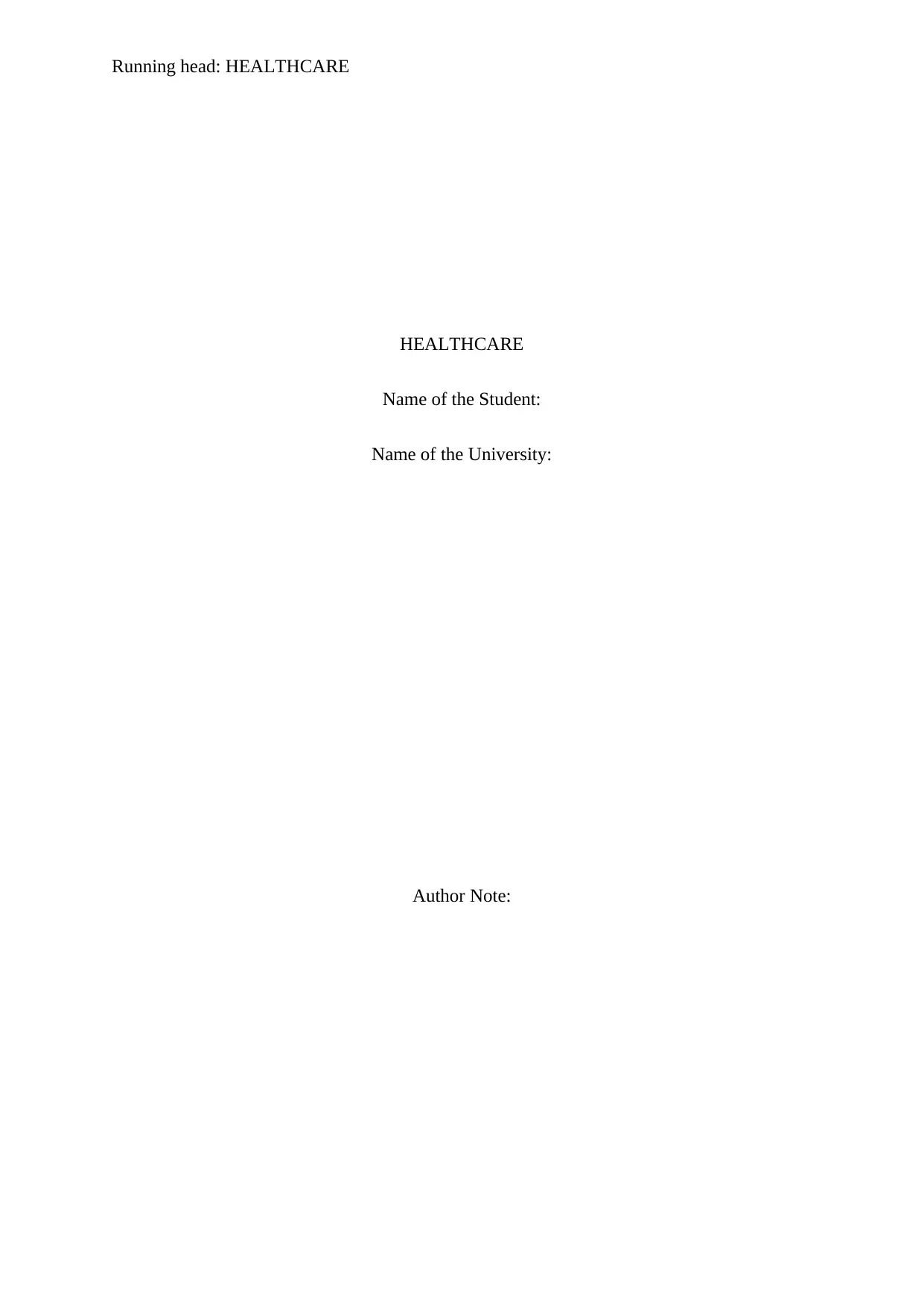
Running head: HEALTHCARE
HEALTHCARE
Name of the Student:
Name of the University:
Author Note:
HEALTHCARE
Name of the Student:
Name of the University:
Author Note:
Secure Best Marks with AI Grader
Need help grading? Try our AI Grader for instant feedback on your assignments.
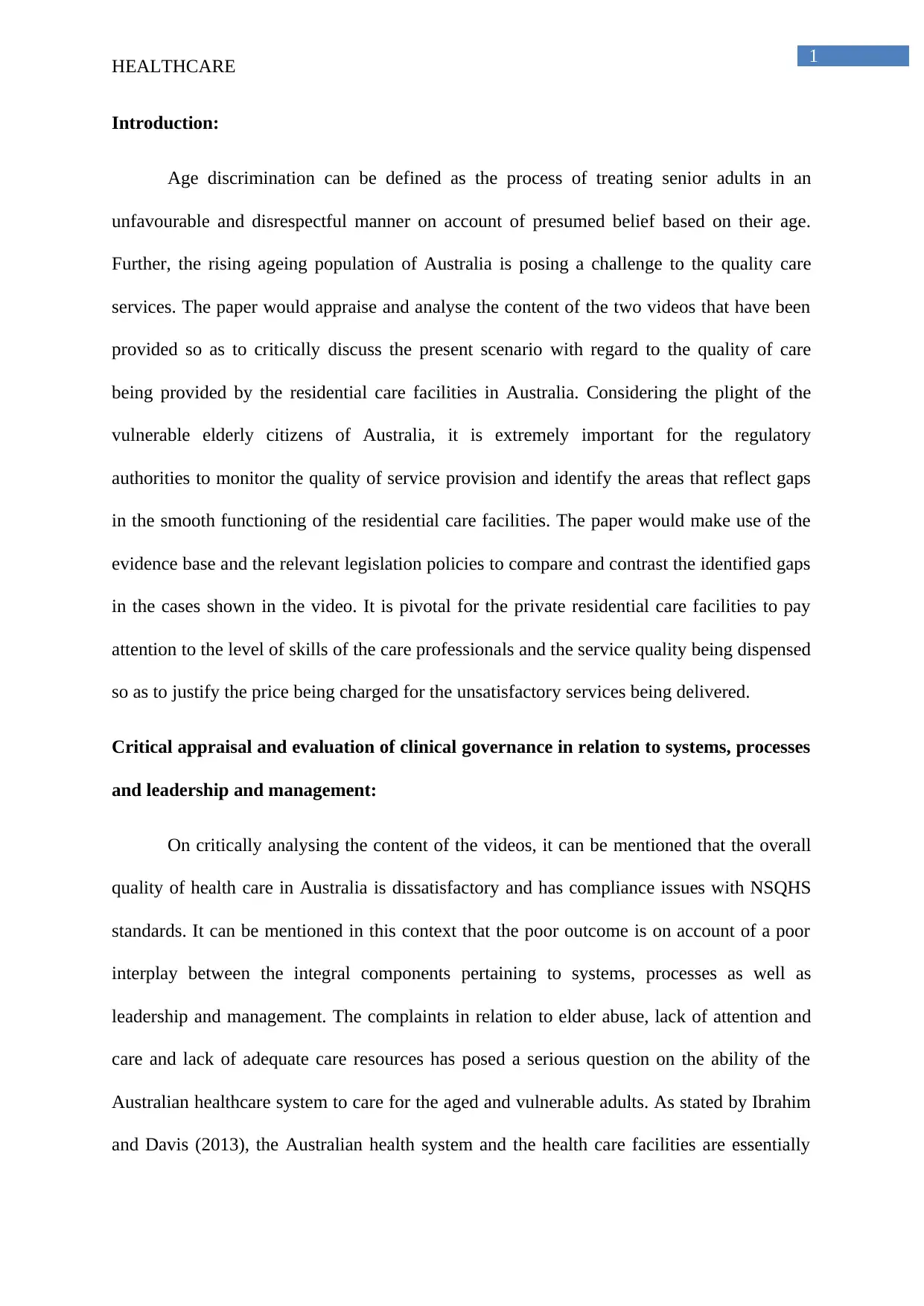
1
HEALTHCARE
Introduction:
Age discrimination can be defined as the process of treating senior adults in an
unfavourable and disrespectful manner on account of presumed belief based on their age.
Further, the rising ageing population of Australia is posing a challenge to the quality care
services. The paper would appraise and analyse the content of the two videos that have been
provided so as to critically discuss the present scenario with regard to the quality of care
being provided by the residential care facilities in Australia. Considering the plight of the
vulnerable elderly citizens of Australia, it is extremely important for the regulatory
authorities to monitor the quality of service provision and identify the areas that reflect gaps
in the smooth functioning of the residential care facilities. The paper would make use of the
evidence base and the relevant legislation policies to compare and contrast the identified gaps
in the cases shown in the video. It is pivotal for the private residential care facilities to pay
attention to the level of skills of the care professionals and the service quality being dispensed
so as to justify the price being charged for the unsatisfactory services being delivered.
Critical appraisal and evaluation of clinical governance in relation to systems, processes
and leadership and management:
On critically analysing the content of the videos, it can be mentioned that the overall
quality of health care in Australia is dissatisfactory and has compliance issues with NSQHS
standards. It can be mentioned in this context that the poor outcome is on account of a poor
interplay between the integral components pertaining to systems, processes as well as
leadership and management. The complaints in relation to elder abuse, lack of attention and
care and lack of adequate care resources has posed a serious question on the ability of the
Australian healthcare system to care for the aged and vulnerable adults. As stated by Ibrahim
and Davis (2013), the Australian health system and the health care facilities are essentially
HEALTHCARE
Introduction:
Age discrimination can be defined as the process of treating senior adults in an
unfavourable and disrespectful manner on account of presumed belief based on their age.
Further, the rising ageing population of Australia is posing a challenge to the quality care
services. The paper would appraise and analyse the content of the two videos that have been
provided so as to critically discuss the present scenario with regard to the quality of care
being provided by the residential care facilities in Australia. Considering the plight of the
vulnerable elderly citizens of Australia, it is extremely important for the regulatory
authorities to monitor the quality of service provision and identify the areas that reflect gaps
in the smooth functioning of the residential care facilities. The paper would make use of the
evidence base and the relevant legislation policies to compare and contrast the identified gaps
in the cases shown in the video. It is pivotal for the private residential care facilities to pay
attention to the level of skills of the care professionals and the service quality being dispensed
so as to justify the price being charged for the unsatisfactory services being delivered.
Critical appraisal and evaluation of clinical governance in relation to systems, processes
and leadership and management:
On critically analysing the content of the videos, it can be mentioned that the overall
quality of health care in Australia is dissatisfactory and has compliance issues with NSQHS
standards. It can be mentioned in this context that the poor outcome is on account of a poor
interplay between the integral components pertaining to systems, processes as well as
leadership and management. The complaints in relation to elder abuse, lack of attention and
care and lack of adequate care resources has posed a serious question on the ability of the
Australian healthcare system to care for the aged and vulnerable adults. As stated by Ibrahim
and Davis (2013), the Australian health system and the health care facilities are essentially
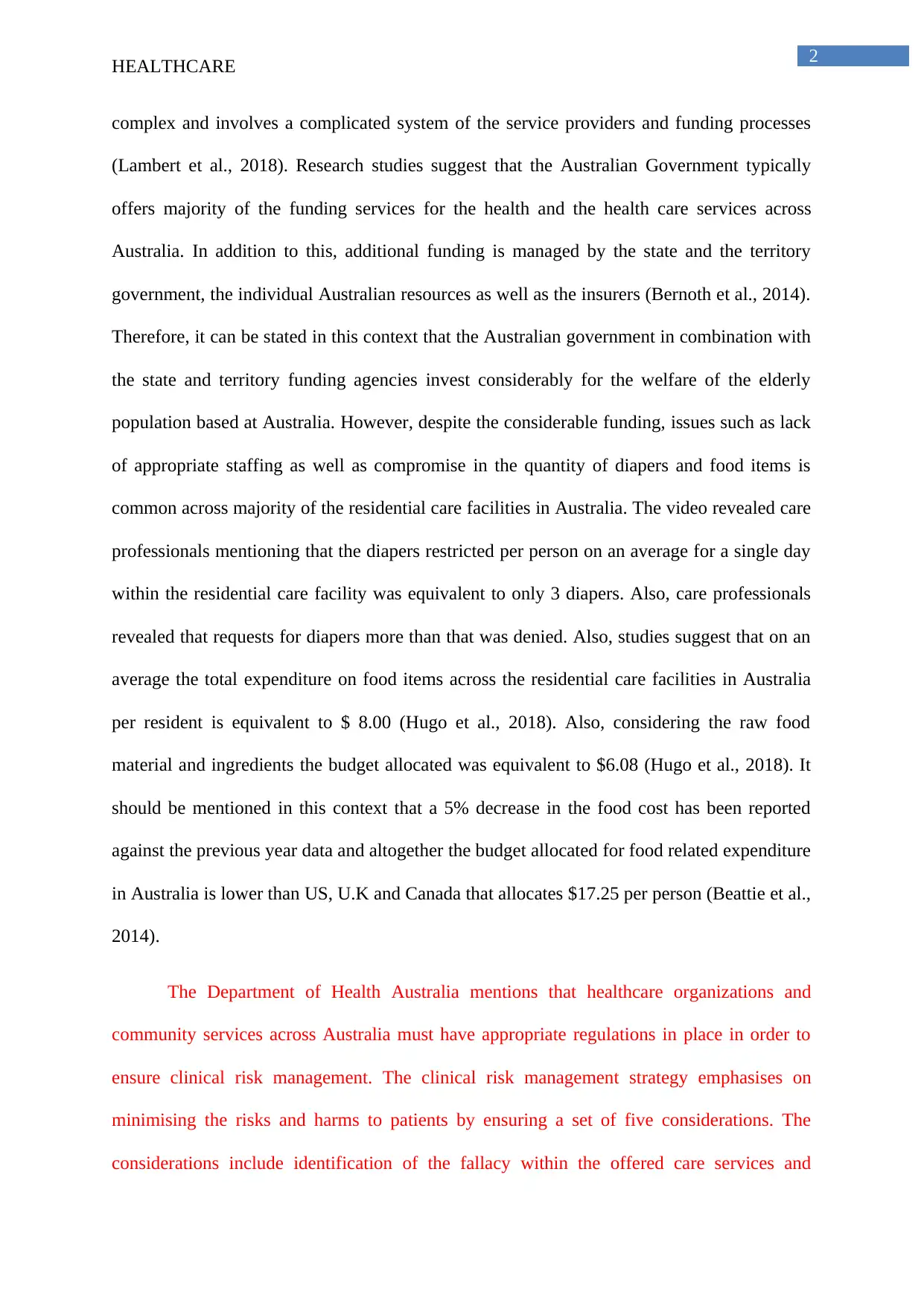
2
HEALTHCARE
complex and involves a complicated system of the service providers and funding processes
(Lambert et al., 2018). Research studies suggest that the Australian Government typically
offers majority of the funding services for the health and the health care services across
Australia. In addition to this, additional funding is managed by the state and the territory
government, the individual Australian resources as well as the insurers (Bernoth et al., 2014).
Therefore, it can be stated in this context that the Australian government in combination with
the state and territory funding agencies invest considerably for the welfare of the elderly
population based at Australia. However, despite the considerable funding, issues such as lack
of appropriate staffing as well as compromise in the quantity of diapers and food items is
common across majority of the residential care facilities in Australia. The video revealed care
professionals mentioning that the diapers restricted per person on an average for a single day
within the residential care facility was equivalent to only 3 diapers. Also, care professionals
revealed that requests for diapers more than that was denied. Also, studies suggest that on an
average the total expenditure on food items across the residential care facilities in Australia
per resident is equivalent to $ 8.00 (Hugo et al., 2018). Also, considering the raw food
material and ingredients the budget allocated was equivalent to $6.08 (Hugo et al., 2018). It
should be mentioned in this context that a 5% decrease in the food cost has been reported
against the previous year data and altogether the budget allocated for food related expenditure
in Australia is lower than US, U.K and Canada that allocates $17.25 per person (Beattie et al.,
2014).
The Department of Health Australia mentions that healthcare organizations and
community services across Australia must have appropriate regulations in place in order to
ensure clinical risk management. The clinical risk management strategy emphasises on
minimising the risks and harms to patients by ensuring a set of five considerations. The
considerations include identification of the fallacy within the offered care services and
HEALTHCARE
complex and involves a complicated system of the service providers and funding processes
(Lambert et al., 2018). Research studies suggest that the Australian Government typically
offers majority of the funding services for the health and the health care services across
Australia. In addition to this, additional funding is managed by the state and the territory
government, the individual Australian resources as well as the insurers (Bernoth et al., 2014).
Therefore, it can be stated in this context that the Australian government in combination with
the state and territory funding agencies invest considerably for the welfare of the elderly
population based at Australia. However, despite the considerable funding, issues such as lack
of appropriate staffing as well as compromise in the quantity of diapers and food items is
common across majority of the residential care facilities in Australia. The video revealed care
professionals mentioning that the diapers restricted per person on an average for a single day
within the residential care facility was equivalent to only 3 diapers. Also, care professionals
revealed that requests for diapers more than that was denied. Also, studies suggest that on an
average the total expenditure on food items across the residential care facilities in Australia
per resident is equivalent to $ 8.00 (Hugo et al., 2018). Also, considering the raw food
material and ingredients the budget allocated was equivalent to $6.08 (Hugo et al., 2018). It
should be mentioned in this context that a 5% decrease in the food cost has been reported
against the previous year data and altogether the budget allocated for food related expenditure
in Australia is lower than US, U.K and Canada that allocates $17.25 per person (Beattie et al.,
2014).
The Department of Health Australia mentions that healthcare organizations and
community services across Australia must have appropriate regulations in place in order to
ensure clinical risk management. The clinical risk management strategy emphasises on
minimising the risks and harms to patients by ensuring a set of five considerations. The
considerations include identification of the fallacy within the offered care services and
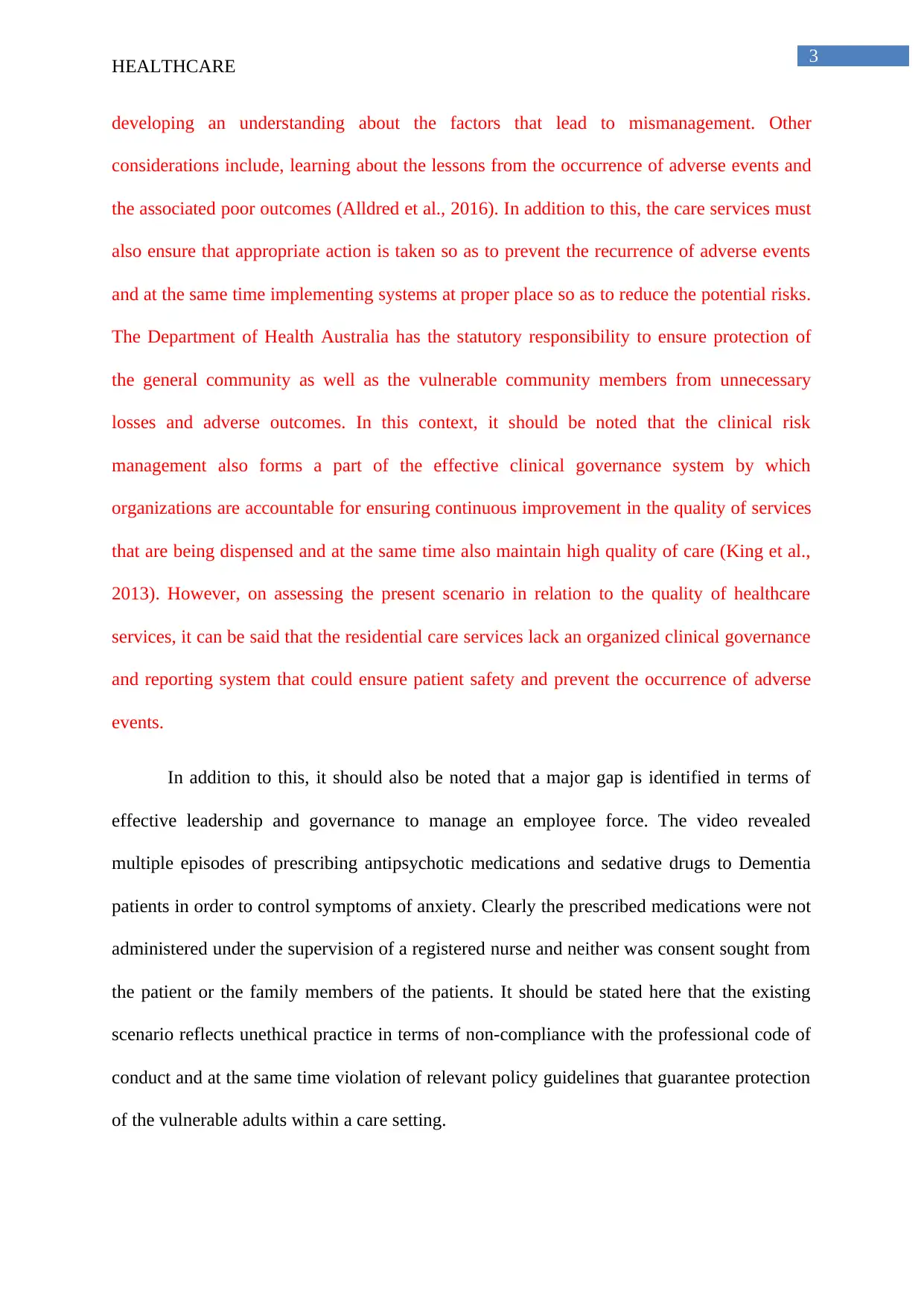
3
HEALTHCARE
developing an understanding about the factors that lead to mismanagement. Other
considerations include, learning about the lessons from the occurrence of adverse events and
the associated poor outcomes (Alldred et al., 2016). In addition to this, the care services must
also ensure that appropriate action is taken so as to prevent the recurrence of adverse events
and at the same time implementing systems at proper place so as to reduce the potential risks.
The Department of Health Australia has the statutory responsibility to ensure protection of
the general community as well as the vulnerable community members from unnecessary
losses and adverse outcomes. In this context, it should be noted that the clinical risk
management also forms a part of the effective clinical governance system by which
organizations are accountable for ensuring continuous improvement in the quality of services
that are being dispensed and at the same time also maintain high quality of care (King et al.,
2013). However, on assessing the present scenario in relation to the quality of healthcare
services, it can be said that the residential care services lack an organized clinical governance
and reporting system that could ensure patient safety and prevent the occurrence of adverse
events.
In addition to this, it should also be noted that a major gap is identified in terms of
effective leadership and governance to manage an employee force. The video revealed
multiple episodes of prescribing antipsychotic medications and sedative drugs to Dementia
patients in order to control symptoms of anxiety. Clearly the prescribed medications were not
administered under the supervision of a registered nurse and neither was consent sought from
the patient or the family members of the patients. It should be stated here that the existing
scenario reflects unethical practice in terms of non-compliance with the professional code of
conduct and at the same time violation of relevant policy guidelines that guarantee protection
of the vulnerable adults within a care setting.
HEALTHCARE
developing an understanding about the factors that lead to mismanagement. Other
considerations include, learning about the lessons from the occurrence of adverse events and
the associated poor outcomes (Alldred et al., 2016). In addition to this, the care services must
also ensure that appropriate action is taken so as to prevent the recurrence of adverse events
and at the same time implementing systems at proper place so as to reduce the potential risks.
The Department of Health Australia has the statutory responsibility to ensure protection of
the general community as well as the vulnerable community members from unnecessary
losses and adverse outcomes. In this context, it should be noted that the clinical risk
management also forms a part of the effective clinical governance system by which
organizations are accountable for ensuring continuous improvement in the quality of services
that are being dispensed and at the same time also maintain high quality of care (King et al.,
2013). However, on assessing the present scenario in relation to the quality of healthcare
services, it can be said that the residential care services lack an organized clinical governance
and reporting system that could ensure patient safety and prevent the occurrence of adverse
events.
In addition to this, it should also be noted that a major gap is identified in terms of
effective leadership and governance to manage an employee force. The video revealed
multiple episodes of prescribing antipsychotic medications and sedative drugs to Dementia
patients in order to control symptoms of anxiety. Clearly the prescribed medications were not
administered under the supervision of a registered nurse and neither was consent sought from
the patient or the family members of the patients. It should be stated here that the existing
scenario reflects unethical practice in terms of non-compliance with the professional code of
conduct and at the same time violation of relevant policy guidelines that guarantee protection
of the vulnerable adults within a care setting.
Secure Best Marks with AI Grader
Need help grading? Try our AI Grader for instant feedback on your assignments.
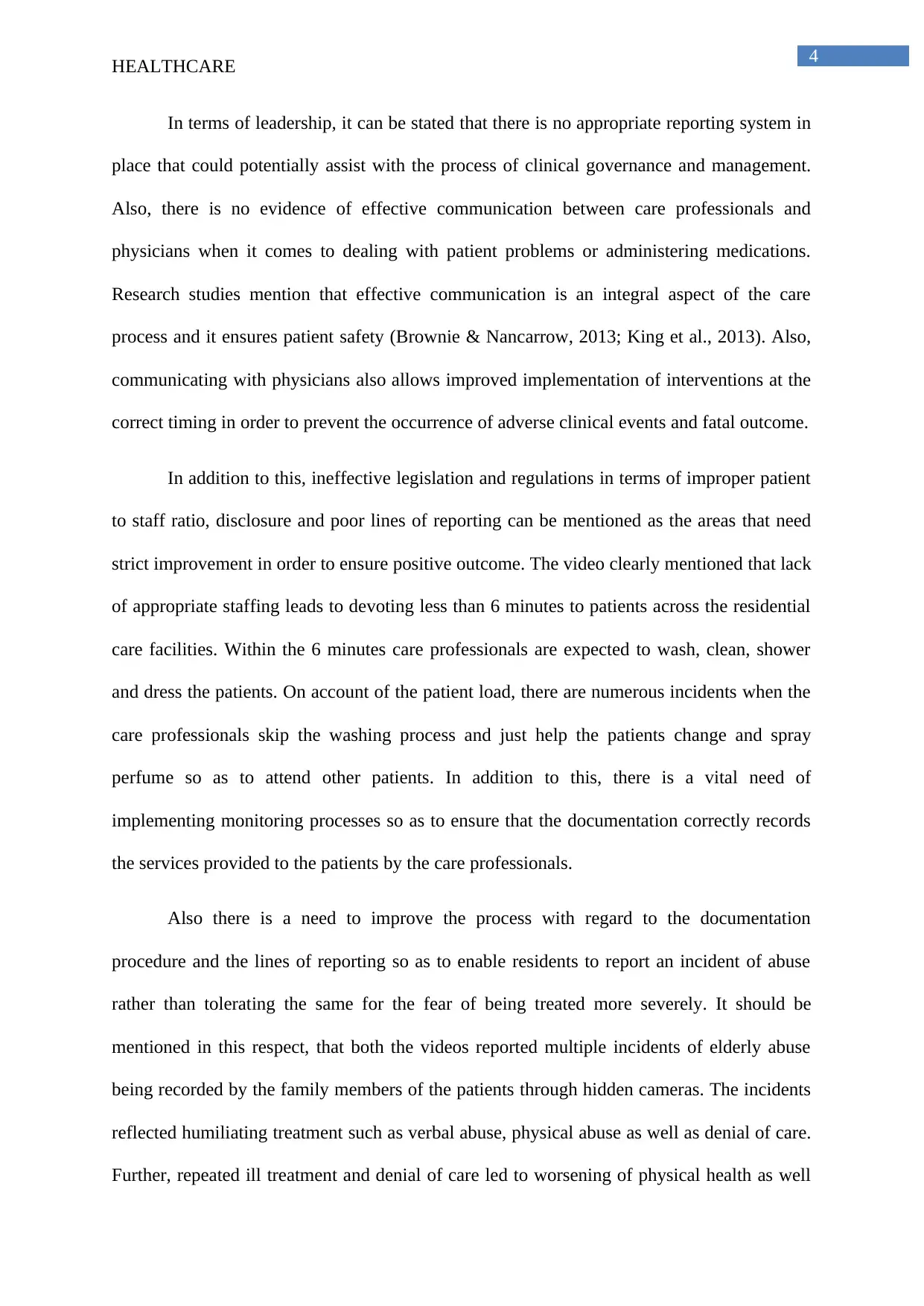
4
HEALTHCARE
In terms of leadership, it can be stated that there is no appropriate reporting system in
place that could potentially assist with the process of clinical governance and management.
Also, there is no evidence of effective communication between care professionals and
physicians when it comes to dealing with patient problems or administering medications.
Research studies mention that effective communication is an integral aspect of the care
process and it ensures patient safety (Brownie & Nancarrow, 2013; King et al., 2013). Also,
communicating with physicians also allows improved implementation of interventions at the
correct timing in order to prevent the occurrence of adverse clinical events and fatal outcome.
In addition to this, ineffective legislation and regulations in terms of improper patient
to staff ratio, disclosure and poor lines of reporting can be mentioned as the areas that need
strict improvement in order to ensure positive outcome. The video clearly mentioned that lack
of appropriate staffing leads to devoting less than 6 minutes to patients across the residential
care facilities. Within the 6 minutes care professionals are expected to wash, clean, shower
and dress the patients. On account of the patient load, there are numerous incidents when the
care professionals skip the washing process and just help the patients change and spray
perfume so as to attend other patients. In addition to this, there is a vital need of
implementing monitoring processes so as to ensure that the documentation correctly records
the services provided to the patients by the care professionals.
Also there is a need to improve the process with regard to the documentation
procedure and the lines of reporting so as to enable residents to report an incident of abuse
rather than tolerating the same for the fear of being treated more severely. It should be
mentioned in this respect, that both the videos reported multiple incidents of elderly abuse
being recorded by the family members of the patients through hidden cameras. The incidents
reflected humiliating treatment such as verbal abuse, physical abuse as well as denial of care.
Further, repeated ill treatment and denial of care led to worsening of physical health as well
HEALTHCARE
In terms of leadership, it can be stated that there is no appropriate reporting system in
place that could potentially assist with the process of clinical governance and management.
Also, there is no evidence of effective communication between care professionals and
physicians when it comes to dealing with patient problems or administering medications.
Research studies mention that effective communication is an integral aspect of the care
process and it ensures patient safety (Brownie & Nancarrow, 2013; King et al., 2013). Also,
communicating with physicians also allows improved implementation of interventions at the
correct timing in order to prevent the occurrence of adverse clinical events and fatal outcome.
In addition to this, ineffective legislation and regulations in terms of improper patient
to staff ratio, disclosure and poor lines of reporting can be mentioned as the areas that need
strict improvement in order to ensure positive outcome. The video clearly mentioned that lack
of appropriate staffing leads to devoting less than 6 minutes to patients across the residential
care facilities. Within the 6 minutes care professionals are expected to wash, clean, shower
and dress the patients. On account of the patient load, there are numerous incidents when the
care professionals skip the washing process and just help the patients change and spray
perfume so as to attend other patients. In addition to this, there is a vital need of
implementing monitoring processes so as to ensure that the documentation correctly records
the services provided to the patients by the care professionals.
Also there is a need to improve the process with regard to the documentation
procedure and the lines of reporting so as to enable residents to report an incident of abuse
rather than tolerating the same for the fear of being treated more severely. It should be
mentioned in this respect, that both the videos reported multiple incidents of elderly abuse
being recorded by the family members of the patients through hidden cameras. The incidents
reflected humiliating treatment such as verbal abuse, physical abuse as well as denial of care.
Further, repeated ill treatment and denial of care led to worsening of physical health as well
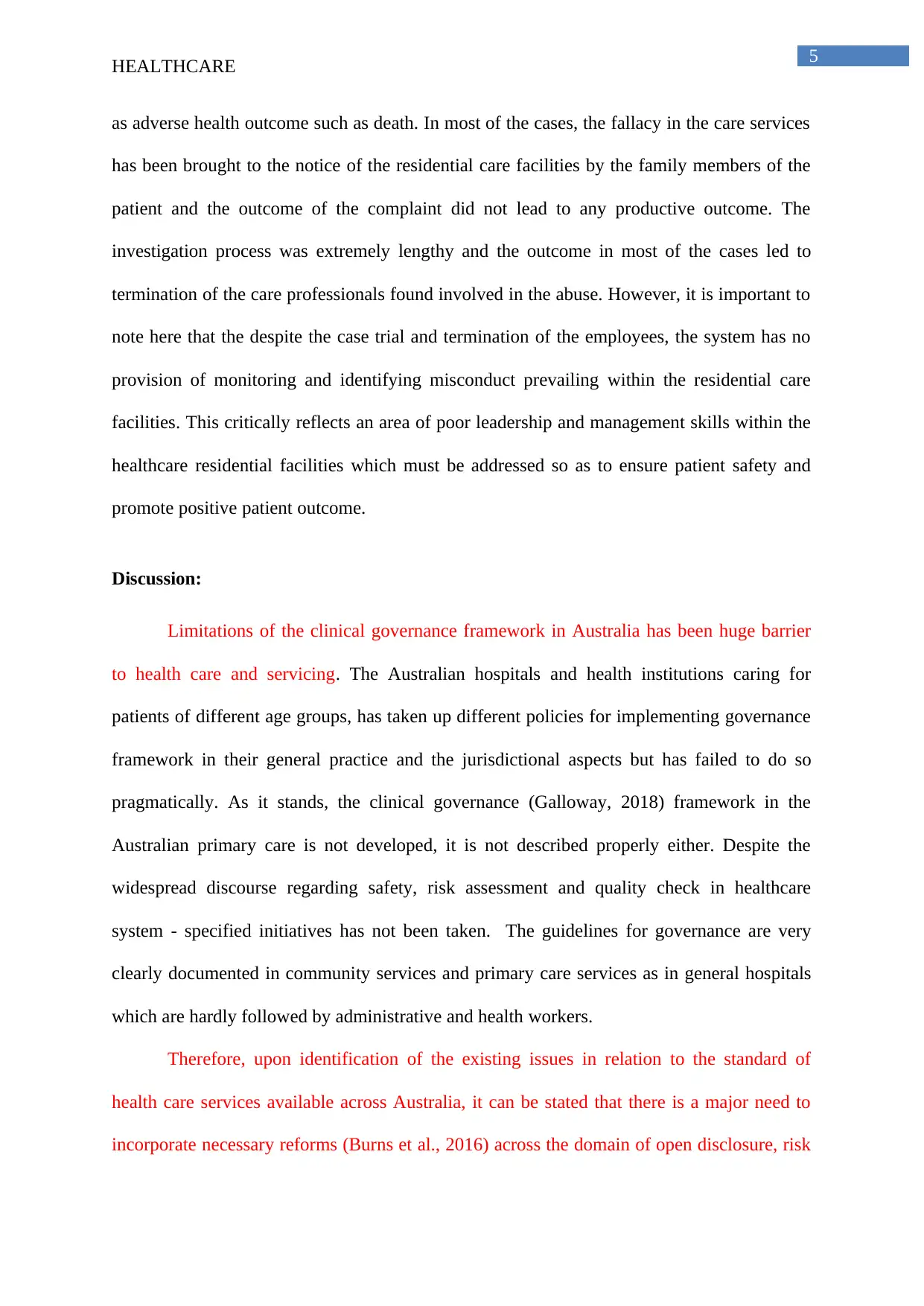
5
HEALTHCARE
as adverse health outcome such as death. In most of the cases, the fallacy in the care services
has been brought to the notice of the residential care facilities by the family members of the
patient and the outcome of the complaint did not lead to any productive outcome. The
investigation process was extremely lengthy and the outcome in most of the cases led to
termination of the care professionals found involved in the abuse. However, it is important to
note here that the despite the case trial and termination of the employees, the system has no
provision of monitoring and identifying misconduct prevailing within the residential care
facilities. This critically reflects an area of poor leadership and management skills within the
healthcare residential facilities which must be addressed so as to ensure patient safety and
promote positive patient outcome.
Discussion:
Limitations of the clinical governance framework in Australia has been huge barrier
to health care and servicing. The Australian hospitals and health institutions caring for
patients of different age groups, has taken up different policies for implementing governance
framework in their general practice and the jurisdictional aspects but has failed to do so
pragmatically. As it stands, the clinical governance (Galloway, 2018) framework in the
Australian primary care is not developed, it is not described properly either. Despite the
widespread discourse regarding safety, risk assessment and quality check in healthcare
system - specified initiatives has not been taken. The guidelines for governance are very
clearly documented in community services and primary care services as in general hospitals
which are hardly followed by administrative and health workers.
Therefore, upon identification of the existing issues in relation to the standard of
health care services available across Australia, it can be stated that there is a major need to
incorporate necessary reforms (Burns et al., 2016) across the domain of open disclosure, risk
HEALTHCARE
as adverse health outcome such as death. In most of the cases, the fallacy in the care services
has been brought to the notice of the residential care facilities by the family members of the
patient and the outcome of the complaint did not lead to any productive outcome. The
investigation process was extremely lengthy and the outcome in most of the cases led to
termination of the care professionals found involved in the abuse. However, it is important to
note here that the despite the case trial and termination of the employees, the system has no
provision of monitoring and identifying misconduct prevailing within the residential care
facilities. This critically reflects an area of poor leadership and management skills within the
healthcare residential facilities which must be addressed so as to ensure patient safety and
promote positive patient outcome.
Discussion:
Limitations of the clinical governance framework in Australia has been huge barrier
to health care and servicing. The Australian hospitals and health institutions caring for
patients of different age groups, has taken up different policies for implementing governance
framework in their general practice and the jurisdictional aspects but has failed to do so
pragmatically. As it stands, the clinical governance (Galloway, 2018) framework in the
Australian primary care is not developed, it is not described properly either. Despite the
widespread discourse regarding safety, risk assessment and quality check in healthcare
system - specified initiatives has not been taken. The guidelines for governance are very
clearly documented in community services and primary care services as in general hospitals
which are hardly followed by administrative and health workers.
Therefore, upon identification of the existing issues in relation to the standard of
health care services available across Australia, it can be stated that there is a major need to
incorporate necessary reforms (Burns et al., 2016) across the domain of open disclosure, risk
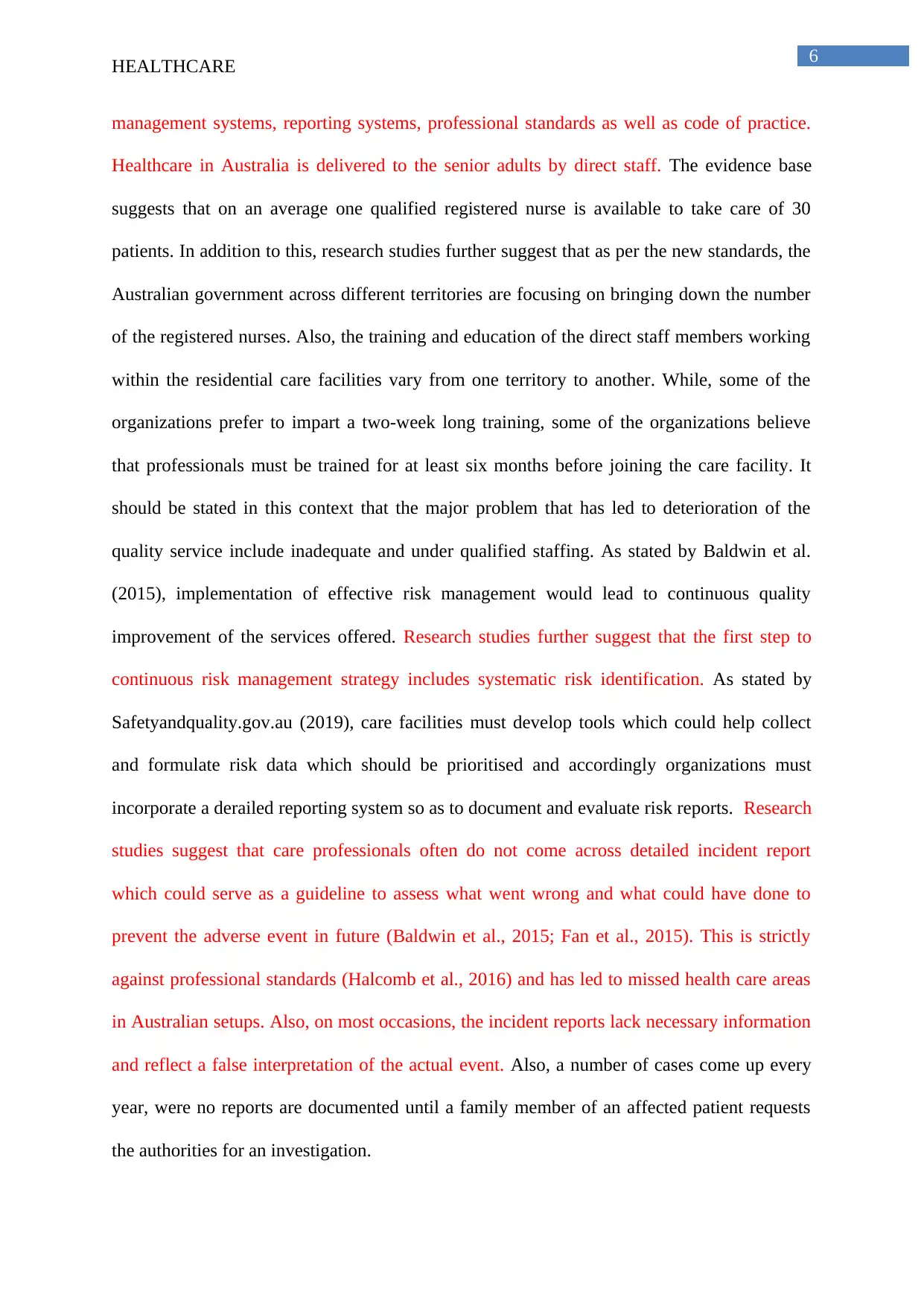
6
HEALTHCARE
management systems, reporting systems, professional standards as well as code of practice.
Healthcare in Australia is delivered to the senior adults by direct staff. The evidence base
suggests that on an average one qualified registered nurse is available to take care of 30
patients. In addition to this, research studies further suggest that as per the new standards, the
Australian government across different territories are focusing on bringing down the number
of the registered nurses. Also, the training and education of the direct staff members working
within the residential care facilities vary from one territory to another. While, some of the
organizations prefer to impart a two-week long training, some of the organizations believe
that professionals must be trained for at least six months before joining the care facility. It
should be stated in this context that the major problem that has led to deterioration of the
quality service include inadequate and under qualified staffing. As stated by Baldwin et al.
(2015), implementation of effective risk management would lead to continuous quality
improvement of the services offered. Research studies further suggest that the first step to
continuous risk management strategy includes systematic risk identification. As stated by
Safetyandquality.gov.au (2019), care facilities must develop tools which could help collect
and formulate risk data which should be prioritised and accordingly organizations must
incorporate a derailed reporting system so as to document and evaluate risk reports. Research
studies suggest that care professionals often do not come across detailed incident report
which could serve as a guideline to assess what went wrong and what could have done to
prevent the adverse event in future (Baldwin et al., 2015; Fan et al., 2015). This is strictly
against professional standards (Halcomb et al., 2016) and has led to missed health care areas
in Australian setups. Also, on most occasions, the incident reports lack necessary information
and reflect a false interpretation of the actual event. Also, a number of cases come up every
year, were no reports are documented until a family member of an affected patient requests
the authorities for an investigation.
HEALTHCARE
management systems, reporting systems, professional standards as well as code of practice.
Healthcare in Australia is delivered to the senior adults by direct staff. The evidence base
suggests that on an average one qualified registered nurse is available to take care of 30
patients. In addition to this, research studies further suggest that as per the new standards, the
Australian government across different territories are focusing on bringing down the number
of the registered nurses. Also, the training and education of the direct staff members working
within the residential care facilities vary from one territory to another. While, some of the
organizations prefer to impart a two-week long training, some of the organizations believe
that professionals must be trained for at least six months before joining the care facility. It
should be stated in this context that the major problem that has led to deterioration of the
quality service include inadequate and under qualified staffing. As stated by Baldwin et al.
(2015), implementation of effective risk management would lead to continuous quality
improvement of the services offered. Research studies further suggest that the first step to
continuous risk management strategy includes systematic risk identification. As stated by
Safetyandquality.gov.au (2019), care facilities must develop tools which could help collect
and formulate risk data which should be prioritised and accordingly organizations must
incorporate a derailed reporting system so as to document and evaluate risk reports. Research
studies suggest that care professionals often do not come across detailed incident report
which could serve as a guideline to assess what went wrong and what could have done to
prevent the adverse event in future (Baldwin et al., 2015; Fan et al., 2015). This is strictly
against professional standards (Halcomb et al., 2016) and has led to missed health care areas
in Australian setups. Also, on most occasions, the incident reports lack necessary information
and reflect a false interpretation of the actual event. Also, a number of cases come up every
year, were no reports are documented until a family member of an affected patient requests
the authorities for an investigation.
Paraphrase This Document
Need a fresh take? Get an instant paraphrase of this document with our AI Paraphraser
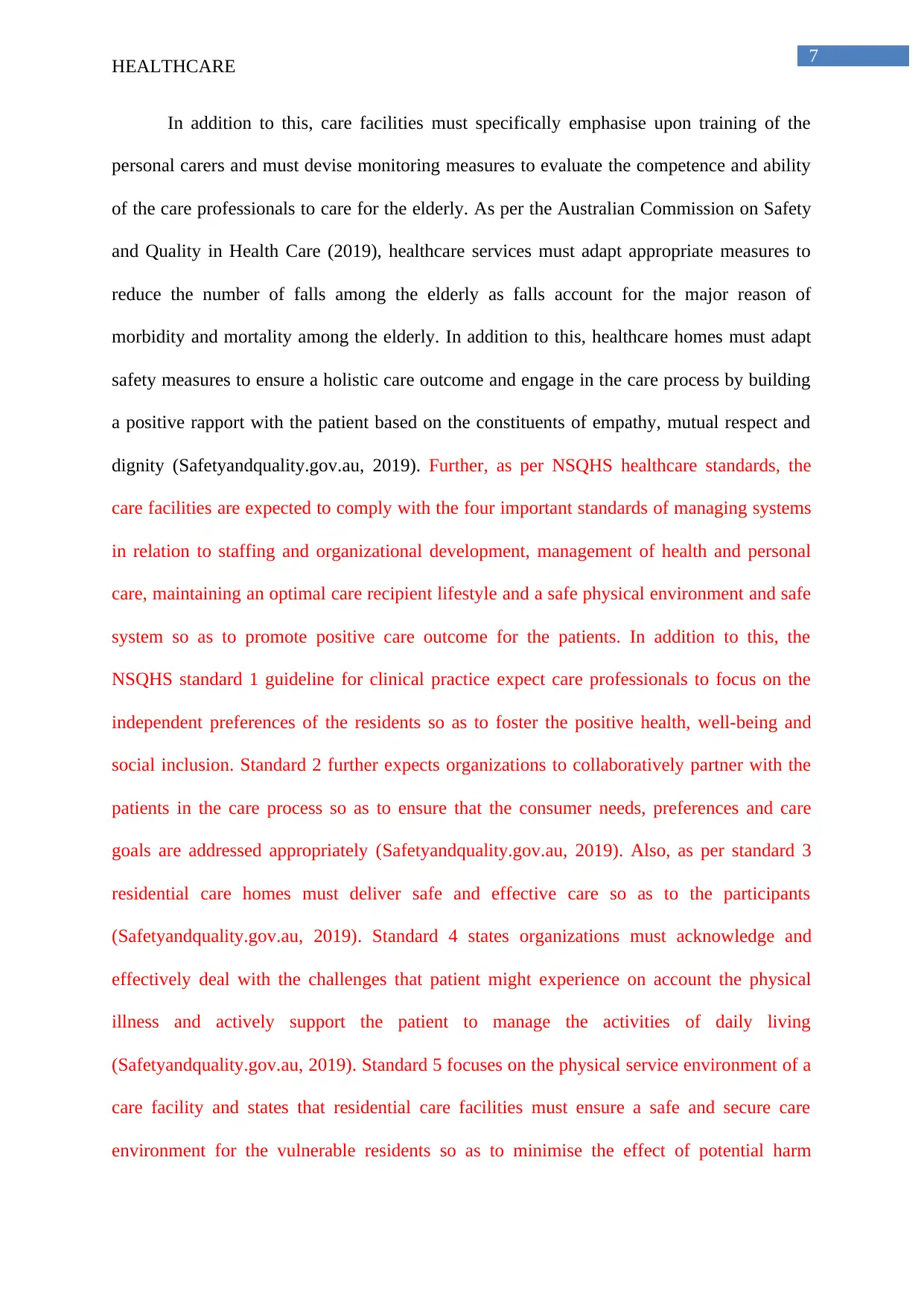
7
HEALTHCARE
In addition to this, care facilities must specifically emphasise upon training of the
personal carers and must devise monitoring measures to evaluate the competence and ability
of the care professionals to care for the elderly. As per the Australian Commission on Safety
and Quality in Health Care (2019), healthcare services must adapt appropriate measures to
reduce the number of falls among the elderly as falls account for the major reason of
morbidity and mortality among the elderly. In addition to this, healthcare homes must adapt
safety measures to ensure a holistic care outcome and engage in the care process by building
a positive rapport with the patient based on the constituents of empathy, mutual respect and
dignity (Safetyandquality.gov.au, 2019). Further, as per NSQHS healthcare standards, the
care facilities are expected to comply with the four important standards of managing systems
in relation to staffing and organizational development, management of health and personal
care, maintaining an optimal care recipient lifestyle and a safe physical environment and safe
system so as to promote positive care outcome for the patients. In addition to this, the
NSQHS standard 1 guideline for clinical practice expect care professionals to focus on the
independent preferences of the residents so as to foster the positive health, well-being and
social inclusion. Standard 2 further expects organizations to collaboratively partner with the
patients in the care process so as to ensure that the consumer needs, preferences and care
goals are addressed appropriately (Safetyandquality.gov.au, 2019). Also, as per standard 3
residential care homes must deliver safe and effective care so as to the participants
(Safetyandquality.gov.au, 2019). Standard 4 states organizations must acknowledge and
effectively deal with the challenges that patient might experience on account the physical
illness and actively support the patient to manage the activities of daily living
(Safetyandquality.gov.au, 2019). Standard 5 focuses on the physical service environment of a
care facility and states that residential care facilities must ensure a safe and secure care
environment for the vulnerable residents so as to minimise the effect of potential harm
HEALTHCARE
In addition to this, care facilities must specifically emphasise upon training of the
personal carers and must devise monitoring measures to evaluate the competence and ability
of the care professionals to care for the elderly. As per the Australian Commission on Safety
and Quality in Health Care (2019), healthcare services must adapt appropriate measures to
reduce the number of falls among the elderly as falls account for the major reason of
morbidity and mortality among the elderly. In addition to this, healthcare homes must adapt
safety measures to ensure a holistic care outcome and engage in the care process by building
a positive rapport with the patient based on the constituents of empathy, mutual respect and
dignity (Safetyandquality.gov.au, 2019). Further, as per NSQHS healthcare standards, the
care facilities are expected to comply with the four important standards of managing systems
in relation to staffing and organizational development, management of health and personal
care, maintaining an optimal care recipient lifestyle and a safe physical environment and safe
system so as to promote positive care outcome for the patients. In addition to this, the
NSQHS standard 1 guideline for clinical practice expect care professionals to focus on the
independent preferences of the residents so as to foster the positive health, well-being and
social inclusion. Standard 2 further expects organizations to collaboratively partner with the
patients in the care process so as to ensure that the consumer needs, preferences and care
goals are addressed appropriately (Safetyandquality.gov.au, 2019). Also, as per standard 3
residential care homes must deliver safe and effective care so as to the participants
(Safetyandquality.gov.au, 2019). Standard 4 states organizations must acknowledge and
effectively deal with the challenges that patient might experience on account the physical
illness and actively support the patient to manage the activities of daily living
(Safetyandquality.gov.au, 2019). Standard 5 focuses on the physical service environment of a
care facility and states that residential care facilities must ensure a safe and secure care
environment for the vulnerable residents so as to minimise the effect of potential harm
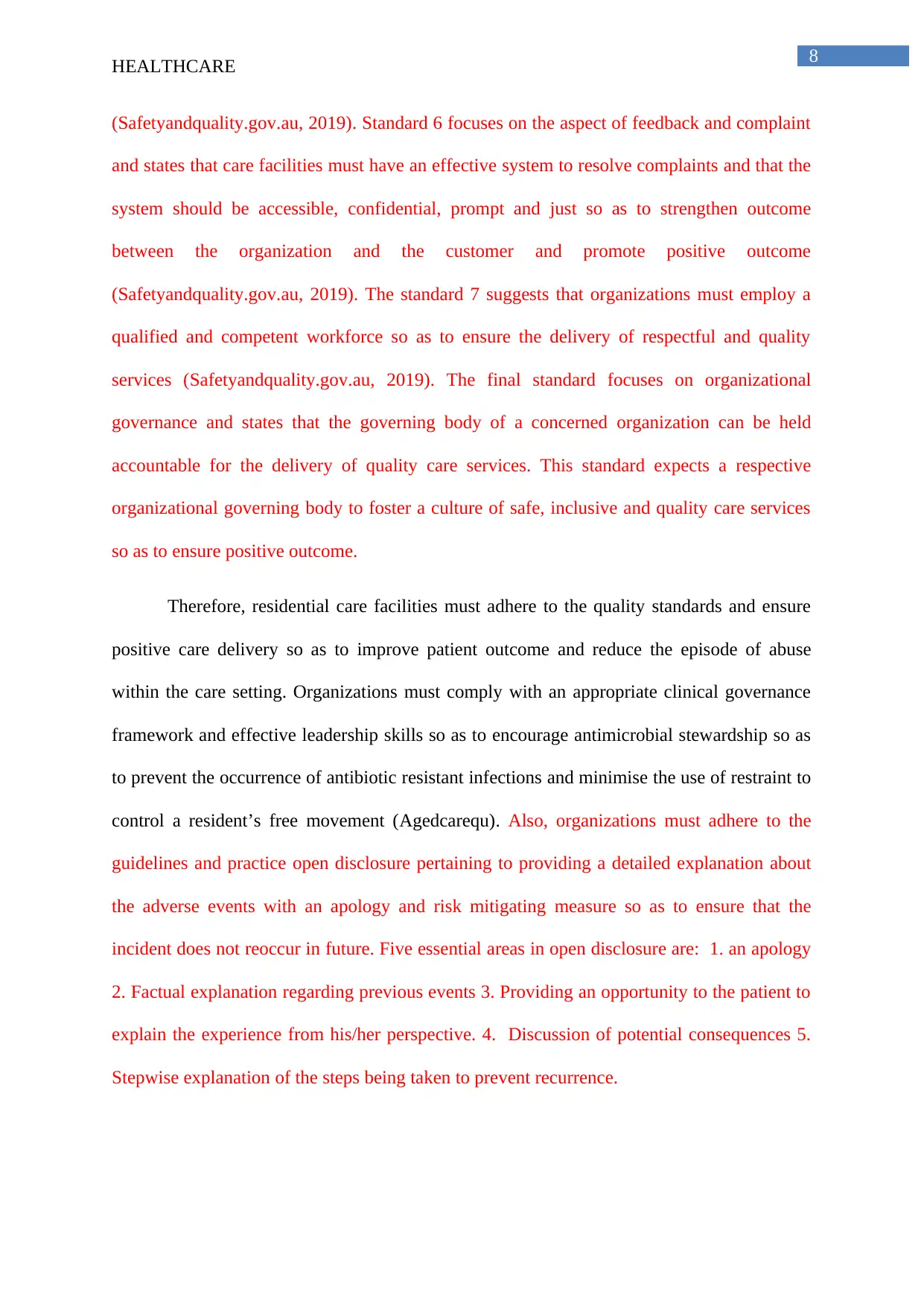
8
HEALTHCARE
(Safetyandquality.gov.au, 2019). Standard 6 focuses on the aspect of feedback and complaint
and states that care facilities must have an effective system to resolve complaints and that the
system should be accessible, confidential, prompt and just so as to strengthen outcome
between the organization and the customer and promote positive outcome
(Safetyandquality.gov.au, 2019). The standard 7 suggests that organizations must employ a
qualified and competent workforce so as to ensure the delivery of respectful and quality
services (Safetyandquality.gov.au, 2019). The final standard focuses on organizational
governance and states that the governing body of a concerned organization can be held
accountable for the delivery of quality care services. This standard expects a respective
organizational governing body to foster a culture of safe, inclusive and quality care services
so as to ensure positive outcome.
Therefore, residential care facilities must adhere to the quality standards and ensure
positive care delivery so as to improve patient outcome and reduce the episode of abuse
within the care setting. Organizations must comply with an appropriate clinical governance
framework and effective leadership skills so as to encourage antimicrobial stewardship so as
to prevent the occurrence of antibiotic resistant infections and minimise the use of restraint to
control a resident’s free movement (Agedcarequ). Also, organizations must adhere to the
guidelines and practice open disclosure pertaining to providing a detailed explanation about
the adverse events with an apology and risk mitigating measure so as to ensure that the
incident does not reoccur in future. Five essential areas in open disclosure are: 1. an apology
2. Factual explanation regarding previous events 3. Providing an opportunity to the patient to
explain the experience from his/her perspective. 4. Discussion of potential consequences 5.
Stepwise explanation of the steps being taken to prevent recurrence.
HEALTHCARE
(Safetyandquality.gov.au, 2019). Standard 6 focuses on the aspect of feedback and complaint
and states that care facilities must have an effective system to resolve complaints and that the
system should be accessible, confidential, prompt and just so as to strengthen outcome
between the organization and the customer and promote positive outcome
(Safetyandquality.gov.au, 2019). The standard 7 suggests that organizations must employ a
qualified and competent workforce so as to ensure the delivery of respectful and quality
services (Safetyandquality.gov.au, 2019). The final standard focuses on organizational
governance and states that the governing body of a concerned organization can be held
accountable for the delivery of quality care services. This standard expects a respective
organizational governing body to foster a culture of safe, inclusive and quality care services
so as to ensure positive outcome.
Therefore, residential care facilities must adhere to the quality standards and ensure
positive care delivery so as to improve patient outcome and reduce the episode of abuse
within the care setting. Organizations must comply with an appropriate clinical governance
framework and effective leadership skills so as to encourage antimicrobial stewardship so as
to prevent the occurrence of antibiotic resistant infections and minimise the use of restraint to
control a resident’s free movement (Agedcarequ). Also, organizations must adhere to the
guidelines and practice open disclosure pertaining to providing a detailed explanation about
the adverse events with an apology and risk mitigating measure so as to ensure that the
incident does not reoccur in future. Five essential areas in open disclosure are: 1. an apology
2. Factual explanation regarding previous events 3. Providing an opportunity to the patient to
explain the experience from his/her perspective. 4. Discussion of potential consequences 5.
Stepwise explanation of the steps being taken to prevent recurrence.
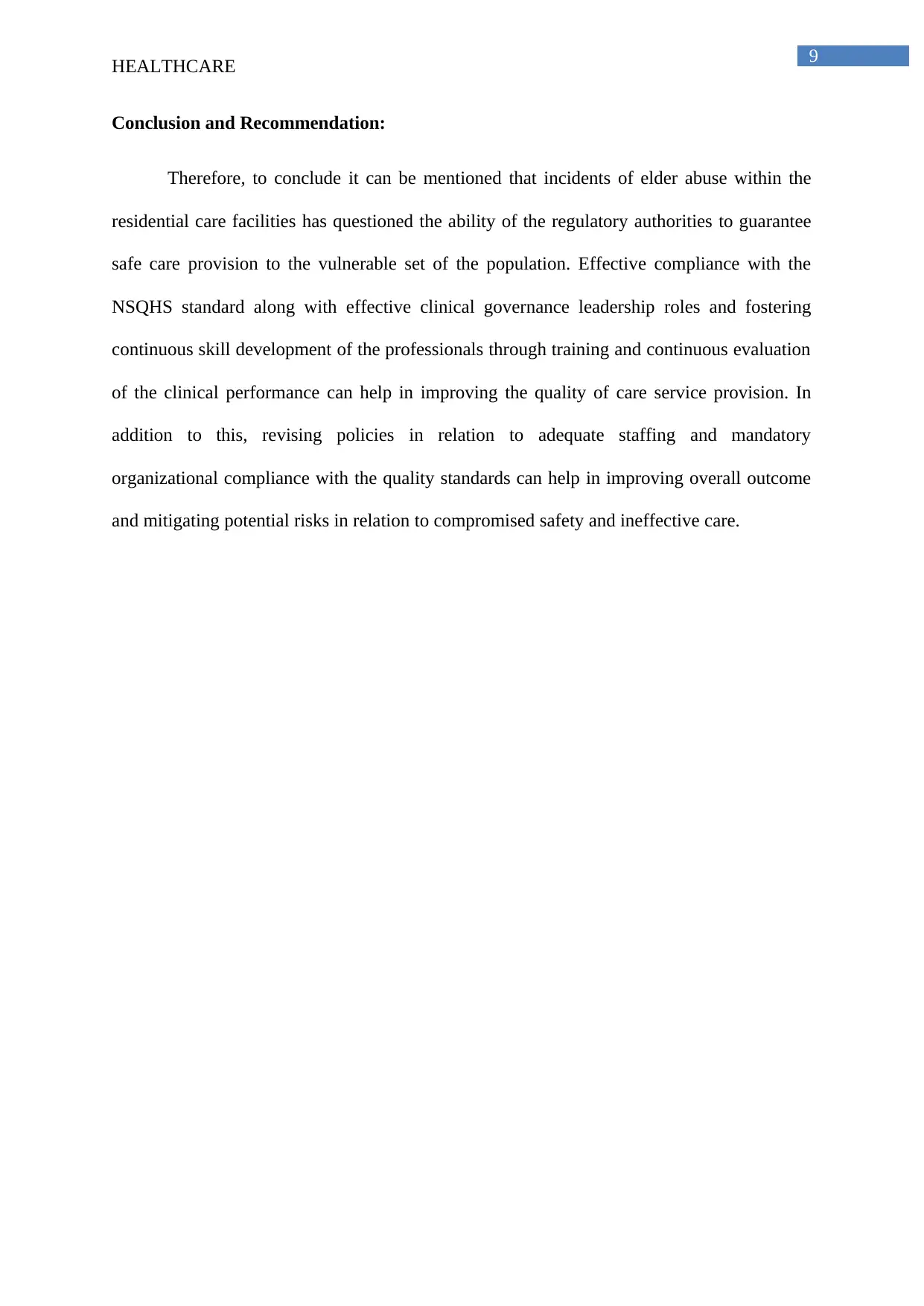
9
HEALTHCARE
Conclusion and Recommendation:
Therefore, to conclude it can be mentioned that incidents of elder abuse within the
residential care facilities has questioned the ability of the regulatory authorities to guarantee
safe care provision to the vulnerable set of the population. Effective compliance with the
NSQHS standard along with effective clinical governance leadership roles and fostering
continuous skill development of the professionals through training and continuous evaluation
of the clinical performance can help in improving the quality of care service provision. In
addition to this, revising policies in relation to adequate staffing and mandatory
organizational compliance with the quality standards can help in improving overall outcome
and mitigating potential risks in relation to compromised safety and ineffective care.
HEALTHCARE
Conclusion and Recommendation:
Therefore, to conclude it can be mentioned that incidents of elder abuse within the
residential care facilities has questioned the ability of the regulatory authorities to guarantee
safe care provision to the vulnerable set of the population. Effective compliance with the
NSQHS standard along with effective clinical governance leadership roles and fostering
continuous skill development of the professionals through training and continuous evaluation
of the clinical performance can help in improving the quality of care service provision. In
addition to this, revising policies in relation to adequate staffing and mandatory
organizational compliance with the quality standards can help in improving overall outcome
and mitigating potential risks in relation to compromised safety and ineffective care.
Secure Best Marks with AI Grader
Need help grading? Try our AI Grader for instant feedback on your assignments.
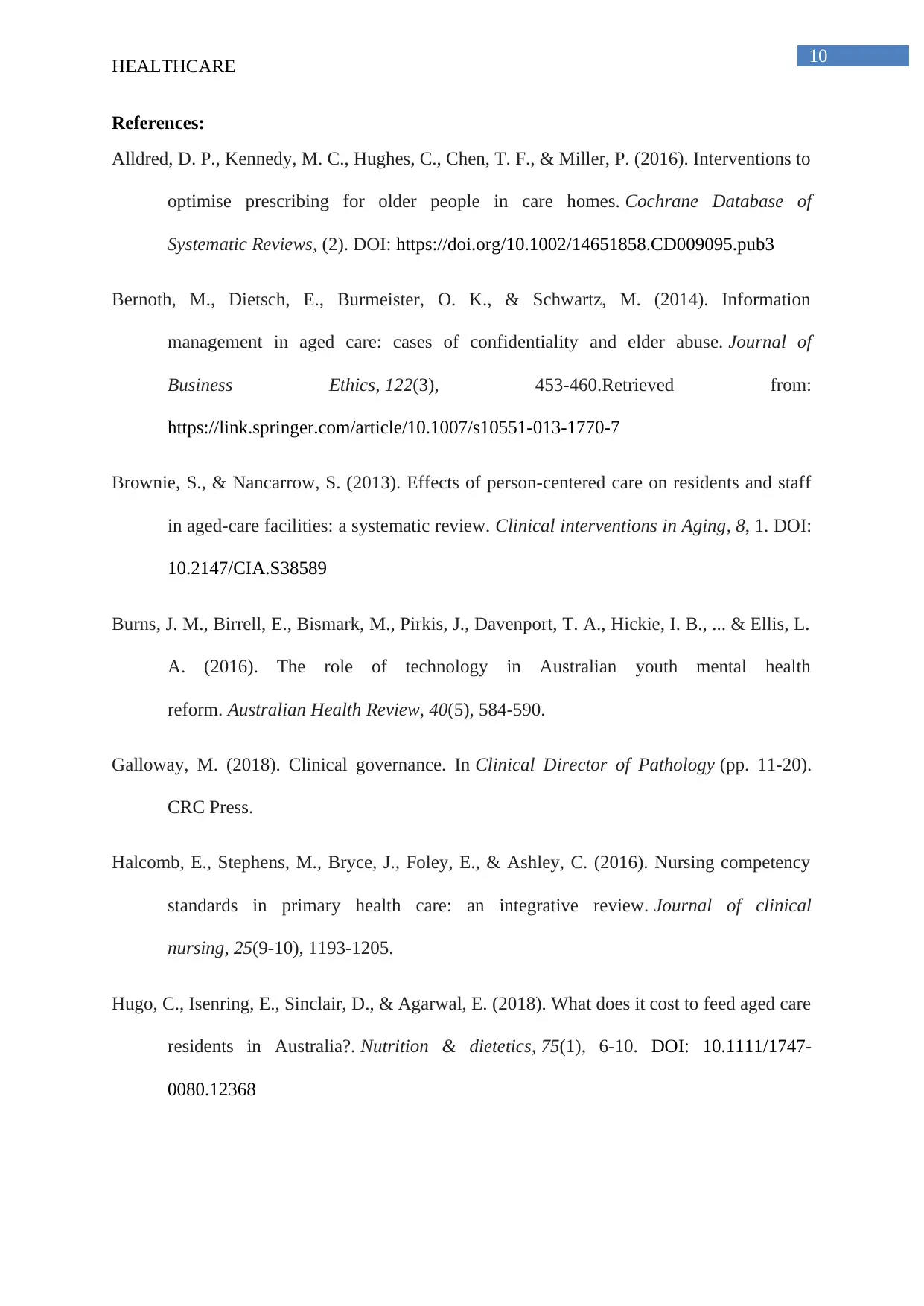
10
HEALTHCARE
References:
Alldred, D. P., Kennedy, M. C., Hughes, C., Chen, T. F., & Miller, P. (2016). Interventions to
optimise prescribing for older people in care homes. Cochrane Database of
Systematic Reviews, (2). DOI: https://doi.org/10.1002/14651858.CD009095.pub3
Bernoth, M., Dietsch, E., Burmeister, O. K., & Schwartz, M. (2014). Information
management in aged care: cases of confidentiality and elder abuse. Journal of
Business Ethics, 122(3), 453-460.Retrieved from:
https://link.springer.com/article/10.1007/s10551-013-1770-7
Brownie, S., & Nancarrow, S. (2013). Effects of person-centered care on residents and staff
in aged-care facilities: a systematic review. Clinical interventions in Aging, 8, 1. DOI:
10.2147/CIA.S38589
Burns, J. M., Birrell, E., Bismark, M., Pirkis, J., Davenport, T. A., Hickie, I. B., ... & Ellis, L.
A. (2016). The role of technology in Australian youth mental health
reform. Australian Health Review, 40(5), 584-590.
Galloway, M. (2018). Clinical governance. In Clinical Director of Pathology (pp. 11-20).
CRC Press.
Halcomb, E., Stephens, M., Bryce, J., Foley, E., & Ashley, C. (2016). Nursing competency
standards in primary health care: an integrative review. Journal of clinical
nursing, 25(9-10), 1193-1205.
Hugo, C., Isenring, E., Sinclair, D., & Agarwal, E. (2018). What does it cost to feed aged care
residents in Australia?. Nutrition & dietetics, 75(1), 6-10. DOI: 10.1111/1747-
0080.12368
HEALTHCARE
References:
Alldred, D. P., Kennedy, M. C., Hughes, C., Chen, T. F., & Miller, P. (2016). Interventions to
optimise prescribing for older people in care homes. Cochrane Database of
Systematic Reviews, (2). DOI: https://doi.org/10.1002/14651858.CD009095.pub3
Bernoth, M., Dietsch, E., Burmeister, O. K., & Schwartz, M. (2014). Information
management in aged care: cases of confidentiality and elder abuse. Journal of
Business Ethics, 122(3), 453-460.Retrieved from:
https://link.springer.com/article/10.1007/s10551-013-1770-7
Brownie, S., & Nancarrow, S. (2013). Effects of person-centered care on residents and staff
in aged-care facilities: a systematic review. Clinical interventions in Aging, 8, 1. DOI:
10.2147/CIA.S38589
Burns, J. M., Birrell, E., Bismark, M., Pirkis, J., Davenport, T. A., Hickie, I. B., ... & Ellis, L.
A. (2016). The role of technology in Australian youth mental health
reform. Australian Health Review, 40(5), 584-590.
Galloway, M. (2018). Clinical governance. In Clinical Director of Pathology (pp. 11-20).
CRC Press.
Halcomb, E., Stephens, M., Bryce, J., Foley, E., & Ashley, C. (2016). Nursing competency
standards in primary health care: an integrative review. Journal of clinical
nursing, 25(9-10), 1193-1205.
Hugo, C., Isenring, E., Sinclair, D., & Agarwal, E. (2018). What does it cost to feed aged care
residents in Australia?. Nutrition & dietetics, 75(1), 6-10. DOI: 10.1111/1747-
0080.12368
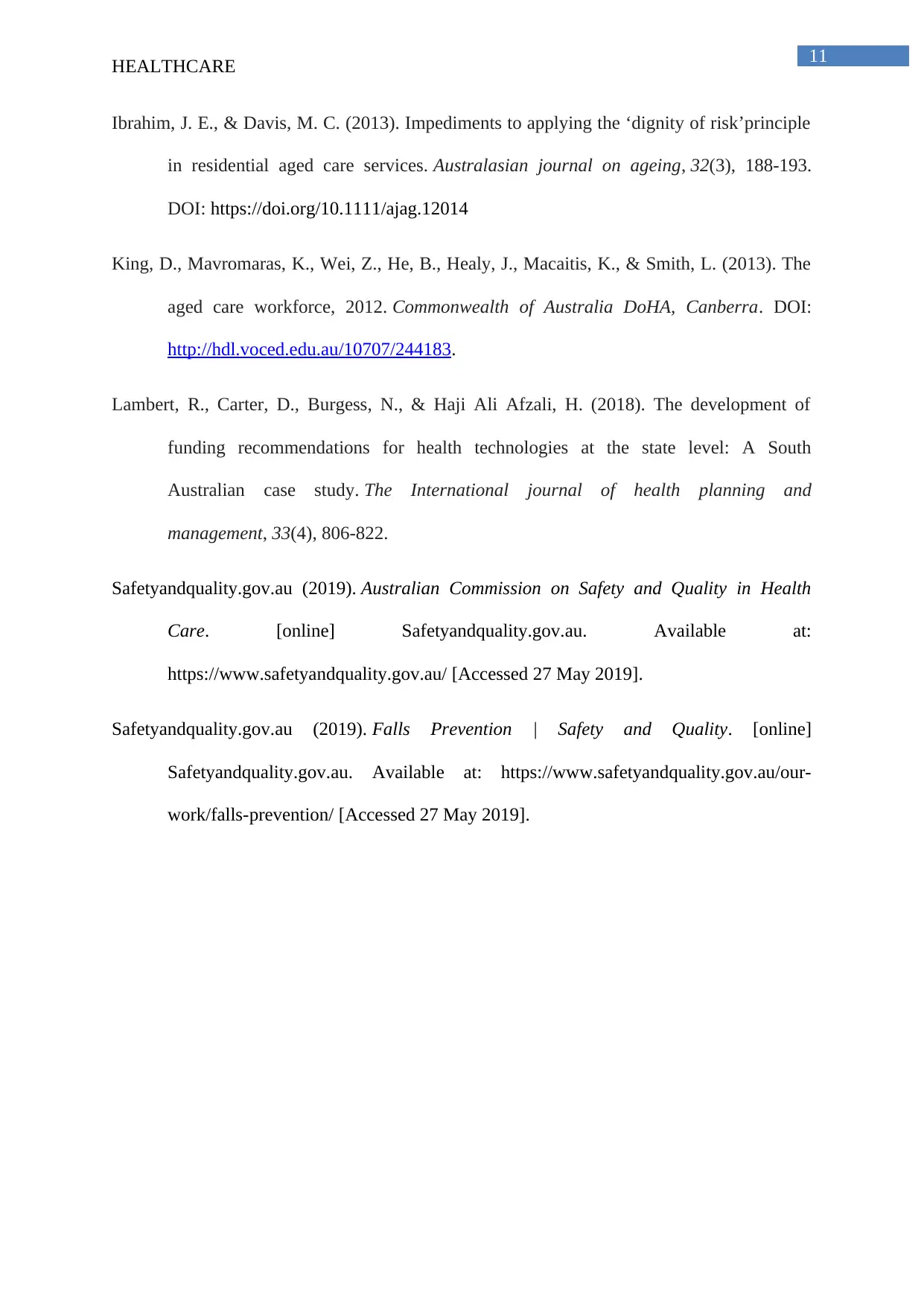
11
HEALTHCARE
Ibrahim, J. E., & Davis, M. C. (2013). Impediments to applying the ‘dignity of risk’principle
in residential aged care services. Australasian journal on ageing, 32(3), 188-193.
DOI: https://doi.org/10.1111/ajag.12014
King, D., Mavromaras, K., Wei, Z., He, B., Healy, J., Macaitis, K., & Smith, L. (2013). The
aged care workforce, 2012. Commonwealth of Australia DoHA, Canberra. DOI:
http://hdl.voced.edu.au/10707/244183.
Lambert, R., Carter, D., Burgess, N., & Haji Ali Afzali, H. (2018). The development of
funding recommendations for health technologies at the state level: A South
Australian case study. The International journal of health planning and
management, 33(4), 806-822.
Safetyandquality.gov.au (2019). Australian Commission on Safety and Quality in Health
Care. [online] Safetyandquality.gov.au. Available at:
https://www.safetyandquality.gov.au/ [Accessed 27 May 2019].
Safetyandquality.gov.au (2019). Falls Prevention | Safety and Quality. [online]
Safetyandquality.gov.au. Available at: https://www.safetyandquality.gov.au/our-
work/falls-prevention/ [Accessed 27 May 2019].
HEALTHCARE
Ibrahim, J. E., & Davis, M. C. (2013). Impediments to applying the ‘dignity of risk’principle
in residential aged care services. Australasian journal on ageing, 32(3), 188-193.
DOI: https://doi.org/10.1111/ajag.12014
King, D., Mavromaras, K., Wei, Z., He, B., Healy, J., Macaitis, K., & Smith, L. (2013). The
aged care workforce, 2012. Commonwealth of Australia DoHA, Canberra. DOI:
http://hdl.voced.edu.au/10707/244183.
Lambert, R., Carter, D., Burgess, N., & Haji Ali Afzali, H. (2018). The development of
funding recommendations for health technologies at the state level: A South
Australian case study. The International journal of health planning and
management, 33(4), 806-822.
Safetyandquality.gov.au (2019). Australian Commission on Safety and Quality in Health
Care. [online] Safetyandquality.gov.au. Available at:
https://www.safetyandquality.gov.au/ [Accessed 27 May 2019].
Safetyandquality.gov.au (2019). Falls Prevention | Safety and Quality. [online]
Safetyandquality.gov.au. Available at: https://www.safetyandquality.gov.au/our-
work/falls-prevention/ [Accessed 27 May 2019].
1 out of 12
Related Documents
Your All-in-One AI-Powered Toolkit for Academic Success.
+13062052269
info@desklib.com
Available 24*7 on WhatsApp / Email
![[object Object]](/_next/static/media/star-bottom.7253800d.svg)
Unlock your academic potential
© 2024 | Zucol Services PVT LTD | All rights reserved.





